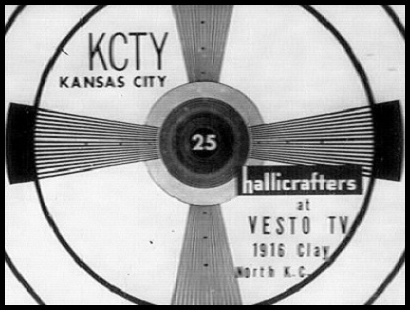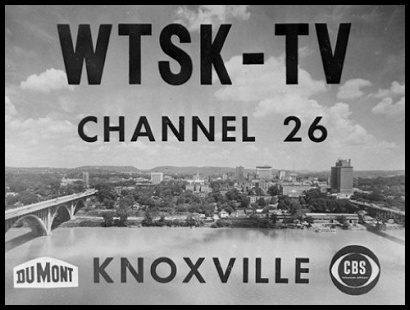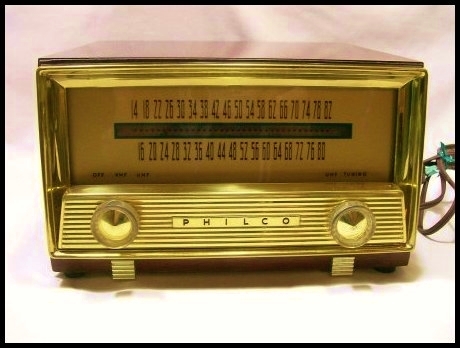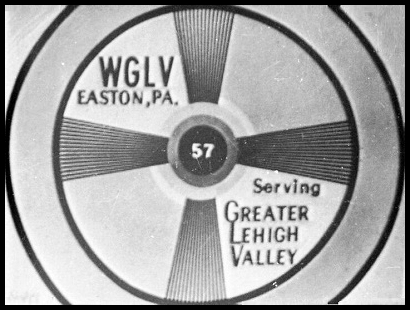 |
Channel  : UHF : UHF

"If there had been four VHF outlets in the top
markets, there's no question DuMont would
have lived and would have eventually turned
the corner in terms of profitability. I have no
doubt in my mind of that at all."
The FCC's Dr. Hyman Goldin, in an interview
with Gary Hess in 1960 (see Channel 11).
One of the factors hampering DuMont in the development of
its television network was the "freeze" on new TV stations imposed by
the FCC in 1948, and the subsequent decision to allocate UHF channels to
television. In assigning television channels to various cities, the FCC
found that it had located a number of stations too close to each other
(channel 4 in Lancaster, Pennsylvania, for example, was too close to
other stations on channel 4 in New York City and Washington, D.C.,
resulting in interference.) At the same time, it was becoming evident
that the existing spectrum of twelve VHF channels, 2 through 13, was
inadequate for nationwide television service. The FCC, therefore,
decided to call a halt to approving new TV stations while it
investigated these problems. DuMont's WDTV, granted a construction
permit in 1948, was one of the last television stations to be authorized
before the "freeze" took effect.
What was intended as a six-month moratorium on the
authorization of new television stations dragged on for years, as the
allocation of UHF channels and the possibilities of color television
were debated. DuMont, believing that UHF would not be competitive for
years, and hoping to establish more VHF network affiliates in large
cities, submitted to the FCC in 1949 a document titled A National
Television Allocation Plan, which proposed that the top 100 markets each
be allocated four VHF channels (one each for CBS, NBC, ABC, and
DuMont), and that additional UHF channels then be assigned to the
largest cities as needed, as well as to smaller markets. This would have
placed DuMont on an equal footing with the other three networks in most
cities, but it also would have greatly displaced existing stations, and
the plan was never adopted. (One can certainly understand why VHF
broadcasters in cities like New York and Los Angeles would have lobbied
hard to avoid moving to the UHF band.)
The "freeze" was finally lifted with the issuance of the
FCC's Sixth Report and Order in 1952, by which time 108 VHF TV stations
-- most of them well-established and profitable network affiliates --
were on the air in the United States. The Sixth Report and Order
required some existing TV stations to change channels (WDTV was one of
these, and switched from channel 3 to channel 2 on November 23, 1952),
but only a few existing VHF stations were required to move to UHF, as a
handful of VHF channels were deleted in places like Peoria, Fresno, and
Bakersfield to create markets which were UHF "islands." The report also
set aside a number of channels for educational television, which
hindered ABC and DuMont's quest for affiliates in markets where VHF
channels were reserved for non-commercial use.
Most significantly, however, the Sixth Report and Order
provided for the "intermixture" of VHF and UHF channels in most markets,
which in the 1950's was an unmitigated disaster. UHF transmitters were
not yet powerful enough, nor receivers sensitive enough (if they
included UHF tuners at all), to make UHF viable against entrenched VHF
stations. In markets like Youngstown, Ohio, Scranton/Wilkes-Barre,
Pennsylvania, and Fort Wayne, Indiana, where there were no VHF stations
and UHF was the only TV service available, UHF survived. In other
markets, which were too small to financially support a television
station, too close to VHF outlets in nearby cities, or where UHF was
forced to compete with more than one well-established VHF station, UHF
had little chance for success.

While it is almost unheard-of for a television station to
go dark today, in the 1950's the demise of UHF TV stations was
commonplace. In Broadcasting The Local News, Lynn Boyd Hinds
tells the story of WENS, channel 16, a UHF station in Pittsburgh which
tried to compete with DuMont's WDTV. Dan Mallinger, a former WENS
employee and later the head of Pittsburgh's AFTRA chapter, explained to
Hinds why so many UHF TV stations signed off in those early years:
There weren't any viewers. At that time, no TV set
had a UHF band on it. You used to have to get a little
box, a converter. And you hooked the converter into
the TV set and then you had to tune it, fine-tune it.
And you never got a fine-tuned picture. It was always
fuzzy. And nobody bothered to buy them. So I
remember at one point the station bought a couple of
hundred of them and went around and gave them
away to all the ad agencies. At least the agencies they
were trying to sell could see it. And everybody at the
station got one to take home. But there was no
viewership, none whatsoever.

1953 Philco UHF converter
(author's collection)
Realizing that under the terms of the Sixth Report and
Order, its future depended on the success of UHF, DuMont bought a UHF
station in Kansas City and attempted to make it viable. The tale of
DuMont's venture into UHF ownership is brief, but enlightening. Television Digest announced the acquisition in its issue of January 2, 1954:
DuMont became the first network to go into UHF
when it acquired Kansas City's KCTY (Channel 25)
from UHF pioneer Herbert Mayer's Empire Coil
Company at 12:01 a.m. New Year's Day. DuMont
already owns three VHF (stations).
The transaction came suddenly, was first broached on
December 29, and approved by the FCC at a special
meeting on December 31. DuMont took over all
equipment and a full 5-year lease on the real estate, as
well as station's obligations, for a nominal cash payment
of $1. The station is well-equipped, even to a remote
unit, has specialized in local originations, (and has)
cost its owners some $750,000 to date in equipment,
property, and operating losses.
DuMont immediately dispatched Donald McGannon,
its assistant director of broadcasting, to supervise the
changeover, and announced that the acquisition will
put the "DuMont network, research and manufacturing
divisions in a position to study at firsthand the problems,
both financial and commercial, faced by (UHF) station
owners." KCTY's staff will be retained intact, at least
for the time being.
The network will funnel 21 of its shows to the station
weekly, and plans to begin a large-scale campaign to
add to the claimed 60 to 70 thousand UHF-equipped
sets in the area. It's also understood the station will
get the first 15 kw DuMont UHF transmitter, when
available (it now has an RCA 1 kw transmitter).
In the same issue, Television Digest also reported some of the problems faced by KCTY's previous owner:
Kansas City was (Empire's) second UHF venture,
its first under the gun of VHF competition. When
KCTY went on the air last June, the only other station
there was pre-freeze WDAF-TV, and other VHF
applicants appeared to be headed for endless FCC
hearings. But mergers and dropouts quickly resulted in
three more VHF rivals...who were able to grab
off most of the local business due to VHF's greater
coverage in heavily VHF-saturated Kansas City.
Vast efforts and funds were poured into the UHF
station in an attempt to gain a foothold, but within a
month, it was evident that the public wasn't willing to
convert fast enough when it could get the programs of
three networks on VHF (KCTY had DuMont).
KCTY went on the market, first at $750,000, then
$400,000, finally $300,000. There were no takers at
any price -- nobody even willing to name his own
figures.
(Empire Coil owner Herbert) Mayer considered going
off the air and salvaging what he could from the sale of
his equipment and property -- which would have been
a better deal financially than the DuMont transaction --
but decided such a move would have a depressing
effect on UHF.
DuMont's ownership of KCTY, however, did not last very long. On February 13, 1954, Television Digest reported:
DuMont this week decided to abandon its UHF
experiment in Kansas City in the interest of "sound
business judgment." The sudden announcement at
week's end told of (DuMont's) decision to close down
KCTY (Channel 25), which it acquired just six weeks
ago from Empire Coil Company for $1 ...
The network said it had studied the situation carefully
and concluded Kansas City viewers were adequately
served by their three VHF outlets. The statement by
Dr. Allen B. DuMont stressed that the problems were
"peculiar to Kansas City and not necessarily fundamental
limitations of UHF broadcasting in general."
KCTY will turn off (the power) February 28th to
become the third UHF station to go off the air --
out of a total of 130 UHF starters. The other two
were Roanoke's WROV-TV and Buffalo's WBES-TV.
Former DuMont managing director Ted Bergmann summed up the company's experience with KCTY in Jeff Kisseloff's The Box:
It had no audience...It cost us a quarter of a million
(dollars) to shut it down. It proved that UHF could
not compete with VHF.
There would be many more UHF failures in the next few
years to prove Bergmann right -- and DuMont would be involved with many
of them. In 1953, DuMont touted WGLV-TV, channel 57,
in Easton, Pennsylvania (a suburb of Allentown) as a high-power UHF
installation which was "100% DuMont equipped." This was, asserted
DuMont, the future of UHF television. Nevertheless, WGLV faltered when
the three Philadelphia VHF stations were permitted to build new, tall
transmitting facilities at Roxborough, providing primary coverage of
Allentown. WGLV and two other UHF stations in the market, as well as UHF
stations in adjacent markets like Atlantic City and Reading, Pennsylvania, quickly folded.

The UHF crisis soon drew the attention of Washington,
where, in 1954, the U.S. Senate held hearings on UHF, and where DuMont
made a last stand for the future of its faltering TV network. (DuMont's
testimony at these hearings is available in its entirety as an appendix
in Ted Bergmann's book.) In the end, however, the hearings accomplished
very little. By 1960, according to Lynn Boyd Hines, there were only 75
UHF stations still on the air -- out of more than double that number
which had originally signed on -- and countless UHF channels left vacant
due to applicants dropping out, or construction permits which were
never built. It would take the FCC's "all-channel" legislation of 1964,
which required all newly-manufactured TV sets to be able to tune UHF
channels, to finally begin to make UHF profitable and successful. This
action came too late to save the DuMont network.
Ironically, in the early 1960's, the FCC made a few
changes to the VHF channel allocations table in order to accommodate
ABC, which was still suffering from a lack of VHF affiliates in several
key markets, but DuMont's fate had been sealed years earlier. As 1955
approached, the end was in sight.
For a listing of long-dark UHF stations, many of which were DuMont network affiliates, see Appendices Ten and Eleven.
(With regard to this particular page, the author wishes
to acknowledge his indebtedness to several articles which appeared in
consecutive issues of the Community Antenna Television Journal (CATJ) in
1974 or 1975. Although uncredited, these articles were almost certainly
the work of CATJ editor-in-chief Robert B. Cooper, Jr. The author
committed much of this material to memory at the time and has
paraphrased some of Cooper's work on this page. Also, the above excerpts
from Television Digest have been revised and edited for punctuation, capitalization, and clarity.)
Go to Channel 7: Finale
|
 |

